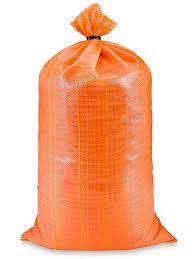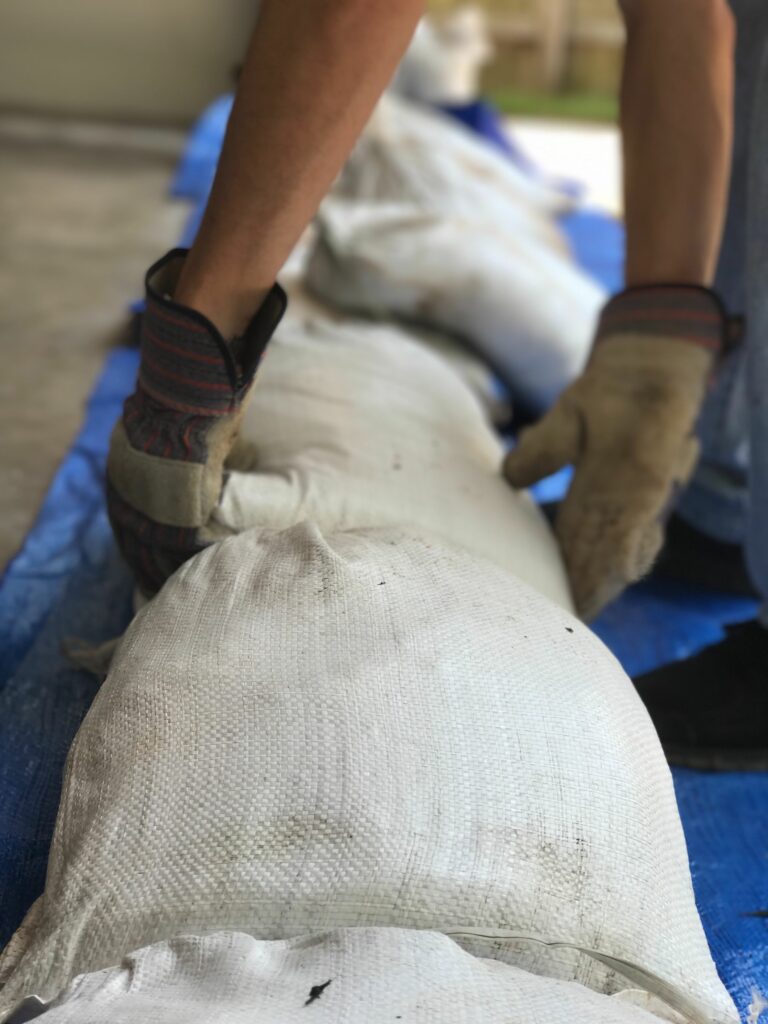Highlights
- Woven polypropylene sandbags are the most common sandbags on the market for a reason: they generally offer good UV protection (ultraviolet light) to help slow the bag’s breakdown and degradation from long-term sun exposure. They can last five years or more.
- UV resistant sandbags made of woven polypropylene are great for long-term flood protection or erosion control where you know that the sandbags may be sitting in direct sunlight for long periods.
- For temporary flood protection use, burlap sand bags (made from jute) are another great option as they’re fully biodegradable. Burlap sandbags are excellent as a temporary erosion control device or even to be buried in the ground, as is common in the oil & gas industries or even in building earthbag homes!
How Long Do Sandbags Last in the Sun?
The typical sandbag is made from woven polypropylene (also called polypropene), a tough “thermoplastic” that’s made through polymerization of propylene (also called propene). Polymerization is the process of turning monomer molecules into more complex (and resilient, in this case) polymer chains.
Polypropylene is similar to polyethylene but is tougher and more heat-resistant.
Here’s the important thing to know: not all polypropylene sandbags are created equal. Polypropylene can be enhanced through additives, including enhancing its UV-resistant properties! Titanium dioxide and zinc oxide (which you may recognize as a sunscreen lotion) are common additives to polypropylene fibers to increase resilience against UV damage.
Simple polyethylene, poor quality sandbags might last as little as 6 to 12 months in direct sunlight before showing signs of wear and leakage, while more optimized polypropylene sandbags can last for five years of consistent outdoor exposure.

How Long Do Polypropylene Sandbags Last Outside?
How long sand bags will last in direct sunlight will vary, but 1-5 years is a fair assumption according to many manufacturers. The takeaway: don’t expect a sandbag, even UV-resistant sandbags, to last forever.
Factors beyond sun and UV exposure will make a big difference outdoors, too: heat contributes to polypropylene breakdown, as does abuse from regular movement. Polypropylene sandbags used to protect doors in shaded areas, like sunken garage doors on the North side of a building in a climate like Manitoba, will last far longer than a sandbag with no shade in sultry Florida.
Importantly, a light-colored sand bag that reflects some light and heat will last longer than black or dark colored sandbags, which will absorb heat and break down more quickly!
What’s The Difference Between Hessian and Polypropylene Sandbags?
Polypropylene sand bags are made from weaving plastic threads into a tight, overlapping weave. They’re inexpensive lightweight, and (with the right material) can last for years outdoors.
Hessian sandbags are made of burlap, another term for jute, which comes from the natural fibers of the jute plant.
The issue with Hessian sand bags when building flood barriers is that they rot when wet. While polypropylene sandbags, even those with UV protection additives, will eventually degrade to a powder, the wet conditions where most sandbags are deployed means rot will likely set in for this natural fiber. From an environmental perspective, that may be ideal, but for function it means jute will not last.
If you’re interested in burlap bags, just make that they offer a high weave count; coarsely woven sandbags will leave gaps and allow for sand or material leakage.
Is There a Standard Sandbag Size?
The standard sandbag size in North America is 14 x 26 inches. (If you’re looking for military grade sand bags, this is it.)
Our standard sand bags for flood prevention have a weight capacity of 60 pounds, which is more than you’ll want to throw around. We recommend filling to about 2/3 full, leaving room for them to lay flat and properly divert water or prevent erosion, and they will weigh 30-40 pounds when full.

FAQs
What size sandbag should I get?
A standard sandbag is 14 x 26 inches or about 35 by 66 centimeters.
Woven polypropylene sandbags can also be purchased in longer tubular shapes from 2 to 5 feet in length. These can be great for flood control needs at doorways or garage doors.
You’ll find more customized polypropylene sandbags in a wide variety of shapes and sizes, though 14 x 26 is the most common selling sandbags.
Can you fill sandbags with other materials?
Absolutely! While sand is the most traditional material used in sandbags and works well because it “molds” to the terrain and other objects, it’s not the only option. Other materials like soil, gravel, or even crushed rock can serve as effective sandbag fill alternatives and can still form a decent sandbag wall. The key is to use materials that are heavy enough to provide weight and stability, small enough to allow for shaping of the bags, and cheap/prevalent enough to fill numerous bags.
Bear in mind, however, that alternative materials might affect the bag’s durability and water resistance compared to dense-packed sand. Sharp gravel rocks, of course, aren’t ideal as they may poke holes in the bag and contribute to faster breakdown. Likewise, an overfilled sandbag bursting at the seams won’t last as long as properly filled heavy duty sandbags.
What does a sandbag weigh?
The weight of a sandbag will vary depending on size and the material used for fill. A standard sandbag is 14 by 26 inches, and when filled with sand, it typically weighs 40-50 pounds (18-23 kilograms). This is manageable for most people and allows for efficient stacking and handling. It’s important NOT to overfill sandbags, and they should be filled to around two-thirds of their capacity for optimal shaping and forming to terrain.
As to what an overfilled sandbag weighs, the sky (and your upper body strength) are the limit!
Can you make sandbags with plastic bags?
In an emergency situation, yes, you can use plastic bags as an alternative to traditional polypropylene or burlap sandbags, though with some caveats.
Plastic bags are readily available and can be a quick solution in emergency situations; however, they’re not nearly as durable as poly or burlap. They simply won’t handle prolonged exposure to environmental factors like UV exposure, physical abuse, or consistent weather. If you’re using plastic grocery bags or trash bags in a pinch, it’s a good idea to double-bag for extra strength.
What’s the easiest way to fill a sandbag?
Filling sandbags is a bit of an art, and for the inexperience will require some trial and error. A smaller shovel or even spade will make for an easier filling operation. A brigade line, in which people pass bags along for filling and stacking along sandbag walls, can speed things up. This is physically demanding work, which is why sandbag filling machines also exist to expedite the process.
What is a homemade alternative to sandbags?
In emergencies, decent homemade alternatives to traditional UV-resistant polypropylene sand bags include pillowcases, grocery bags, or zippered plastic bags filled with backyard soil or gravel. You can also use heavy-duty trash bags, filling them partially and securing them tightly. These alternatives are better than nothing for flood control when you’re in a hurry to create barriers against floodwaters. Always remember not to overfill your bags to prevent breakage and allow them to shape to their environment.
Are there reusable sandbags?
Sure, though they’re not recommended for extensive use. Some manufacturers even make polypropylene sandbags with a velcro closure for easy filling and emptying!
Most inexpensive sandbags can of course be reused, but it can be challenging and messy to empty and refill them frequently.
Looking to Order Sand Bags Right Now?
St Boniface Bags is a leading supplier of sand bags in Manitoba, providing UV resistant sandbags for outdoor use and burlap bags for pipeline construction and more. We also sell FIBC tote bags, onion or potato bags for agriculture, and more.
Order online or call to learn more about bulk sand bag ordering.

Sources
https://www.sciencedirect.com/science/article/abs/pii/S0141391013004515




